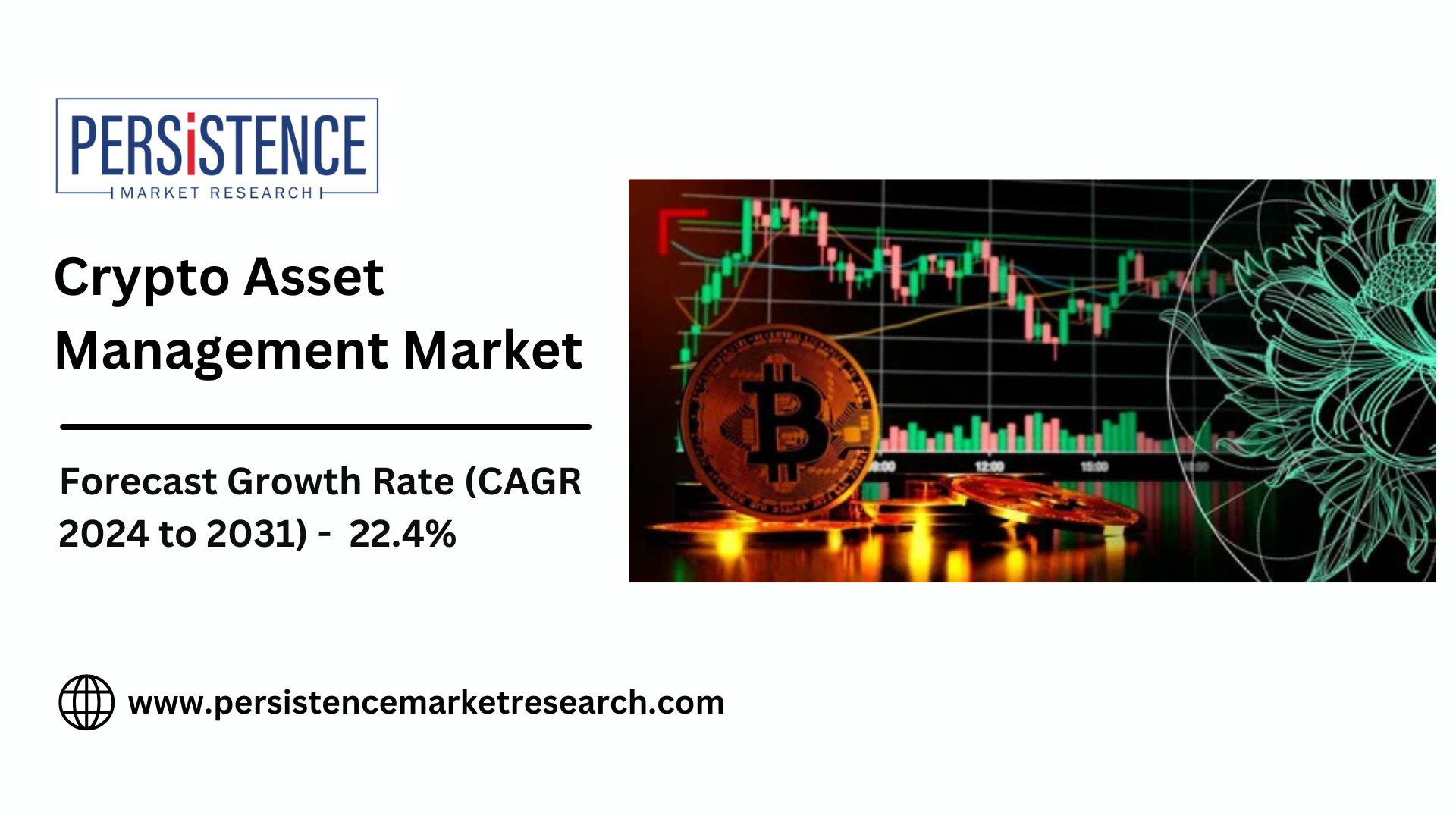 White Hat Link Building – Safe. Powerful. Long-Term.
White Hat Link Building – Safe. Powerful. Long-Term.
Key Trends in Crypto Asset Management Growth
Written by Pooja » Updated on: June 17th, 2025

The crypto asset management market is projected to grow significantly, increasing from US$1.1 billion in 2024 to US$2.28 billion by 2031, with a robust CAGR of 22.4% during this period. The growth is driven by advancements in technologies such as artificial intelligence and machine learning, which enhance portfolio management and transaction processing. The cloud segment is expected to dominate the market due to its scalability and flexibility. North America's growth is fueled by regulatory clarity, institutional investment, and technological innovation, while the Asia Pacific region benefits from widespread cryptocurrency adoption. Countries like Japan, South Korea, Singapore, and Australia are at the forefront of crypto regulation, contributing to the sector's expansion. Additionally, custodian solutions are anticipated to account for 62% of the market's revenue share in 2024.
The crypto asset management industry is witnessing significant growth, driven by multiple trends reshaping the market. From institutional participation to technological advancements, various forces are pushing the boundaries of how digital assets are managed, stored, and invested. Here are the key trends fueling the rapid expansion of the crypto asset management sector:
1. Institutional Adoption on the Rise
One of the most pivotal factors behind the growth of crypto asset management is the increasing involvement of institutional investors. In the early years of cryptocurrency, institutional players were hesitant to enter the space due to volatility, regulatory uncertainty, and concerns over security. However, as the market matures and regulatory clarity improves, more institutions, including hedge funds, mutual funds, pension funds, and family offices, are embracing digital assets as part of their portfolios.
The influx of institutional capital has necessitated the development of robust asset management solutions that can accommodate larger sums of money and meet higher standards of security, transparency, and compliance. The introduction of crypto-related products like exchange-traded funds (ETFs) and futures contracts has further accelerated this trend. Institutions are now more confident in exploring the potential of cryptocurrencies as alternative investments to diversify their holdings.
2. Emergence of Decentralized Finance (DeFi) in Asset Management
Decentralized finance (DeFi) has revolutionized the financial industry, and its impact on crypto asset management is profound. DeFi platforms allow investors to lend, borrow, trade, and earn interest on their cryptocurrencies without intermediaries, offering greater transparency and lower costs. This peer-to-peer financial system is decentralized, meaning it operates without relying on traditional financial institutions, thereby reducing entry barriers for users.
Asset managers are incorporating DeFi into their investment strategies, offering clients access to DeFi protocols that provide higher yields than traditional financial products. Additionally, services such as yield farming and staking, which involve earning rewards by providing liquidity or validating transactions in decentralized networks, are gaining traction as new ways to enhance portfolio returns.
While DeFi introduces a level of risk due to its nascent stage and potential security vulnerabilities, its growth is undeniable. As it becomes more refined, the integration of DeFi into asset management is expected to transform the way assets are managed, particularly in terms of automation, liquidity, and access to global financial markets.
3. Regulatory Advancements Shaping Market Dynamics
The regulatory landscape surrounding cryptocurrency and crypto asset management is evolving, which is a critical driver of market growth. Countries around the world are working to establish clear legal frameworks to govern the use, trading, and management of digital assets. Regulatory clarity provides reassurance to both institutional and retail investors, making them more comfortable with allocating funds to crypto markets.
For instance, the approval of Bitcoin ETFs in several countries and the development of comprehensive tax guidelines for cryptocurrency transactions have made it easier for investors to enter the market with confidence. Regulations focusing on anti-money laundering (AML) and know-your-customer (KYC) requirements are also enhancing the security and legitimacy of crypto investments.
These regulatory advancements are expected to open new doors for institutional investors and large asset management firms. As governments and regulatory bodies continue to refine their approach to digital assets, the crypto asset management market will likely see further expansion in both size and scope.
4. Growing Demand for Custodial Solutions
As the volume and value of crypto holdings increase, so does the need for secure and reliable custodial solutions. Unlike traditional assets, cryptocurrencies are stored in digital wallets, and the loss or theft of private keys can result in the permanent loss of assets. This has created a demand for institutional-grade custody services that offer enhanced security measures such as cold storage, multi-signature wallets, and encryption.
In response, a growing number of crypto asset management firms and third-party providers are offering specialized custody solutions designed to safeguard digital assets. Cold storage, which involves storing private keys offline to protect them from hacking, has become a standard practice for securing large crypto holdings. Additionally, insurance products that cover potential losses from cyberattacks or human error are being integrated into custody services.
As more institutional investors enter the market, the demand for secure custodial solutions will continue to grow, driving innovation and competition in the space. Firms that provide a combination of top-tier security, transparency, and regulatory compliance will be well-positioned to capture a larger share of the asset management market.
5. Tokenization of Real-World Assets
Tokenization—the process of converting physical assets like real estate, commodities, and art into digital tokens on a blockchain—is a trend gaining momentum in the crypto asset management industry. Tokenized assets can be easily traded, divided into smaller shares, and accessed by a broader range of investors, making it possible to buy and sell fractions of high-value assets that were previously illiquid or difficult to trade.
Tokenization opens up new investment opportunities for crypto asset managers, who can offer their clients exposure to a diverse range of assets in a more liquid and accessible manner. For example, tokenized real estate allows investors to buy fractions of properties, providing a new way to diversify portfolios without the need for significant upfront capital.
The rise of tokenized assets is also creating new ways to manage and trade digital and physical assets, enhancing liquidity and broadening investment options. As more industries explore tokenization, crypto asset managers will need to develop strategies and tools to manage these complex portfolios effectively.
6. Proliferation of Crypto Investment Products
As the crypto market matures, a wider array of investment products is emerging to cater to different investor needs. In addition to traditional buying and holding of cryptocurrencies, new financial instruments such as crypto index funds, ETFs, and derivatives like futures and options are being introduced. These products make it easier for investors to gain exposure to digital assets without directly managing them.
The availability of these products has led to an increase in demand for crypto asset management services that offer expertise in navigating the complexities of these instruments. For instance, crypto index funds allow investors to track the performance of a basket of digital assets, providing diversification and reducing the risks associated with holding a single cryptocurrency.
As more sophisticated products enter the market, the role of crypto asset managers will become increasingly important in helping investors understand and capitalize on these opportunities. The development of new financial instruments will likely lead to the creation of specialized management services tailored to different risk appetites and investment goals.
7. Technological Advancements in Blockchain and AI
Advances in blockchain technology, artificial intelligence (AI), and machine learning are transforming the crypto asset management industry. Blockchain technology ensures transparency, immutability, and security of transactions, while AI-driven analytics can provide valuable insights into market trends, asset performance, and risk management.
AI-powered tools are becoming more prevalent in portfolio management, helping asset managers make informed decisions by analyzing large datasets and identifying patterns. Automated trading algorithms, AI-based risk assessment, and machine learning models for predictive analytics are enabling more efficient and effective management of crypto assets.
These technological innovations are making crypto asset management more sophisticated, scalable, and secure. As the market continues to grow, the integration of advanced technologies will play a key role in enhancing the capabilities of asset managers and providing better services to clients.
Conclusion: A Market Poised for Continued Growth
The crypto asset management market is rapidly expanding, driven by key trends such as institutional adoption, DeFi integration, regulatory advancements, and the rise of tokenized assets. As the market matures, the demand for secure, efficient, and innovative management solutions will only increase.
With the ongoing development of blockchain technology, AI tools, and new investment products, the crypto asset management sector is poised for significant growth in the coming years. Asset managers who can stay ahead of these trends will be well-positioned to capitalize on the opportunities that the evolving digital asset landscape has to offer.
Note: IndiBlogHub features both user-submitted and editorial content. We do not verify third-party contributions. Read our Disclaimer and Privacy Policyfor details.
Related Posts
Copyright © 2019-2025 IndiBlogHub.com. All rights reserved. Hosted on DigitalOcean for fast, reliable performance.















